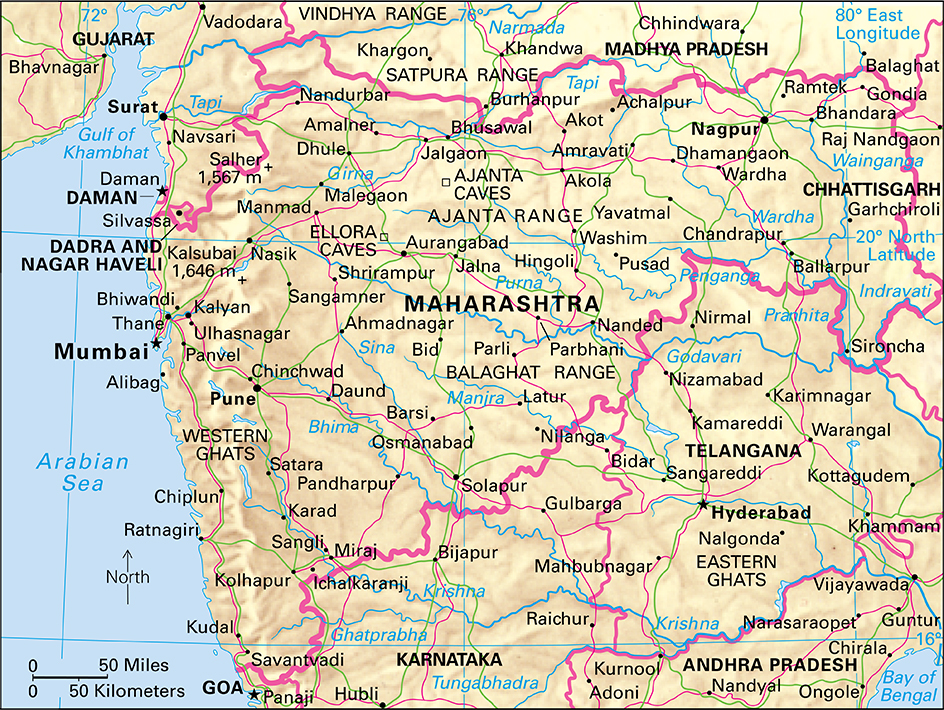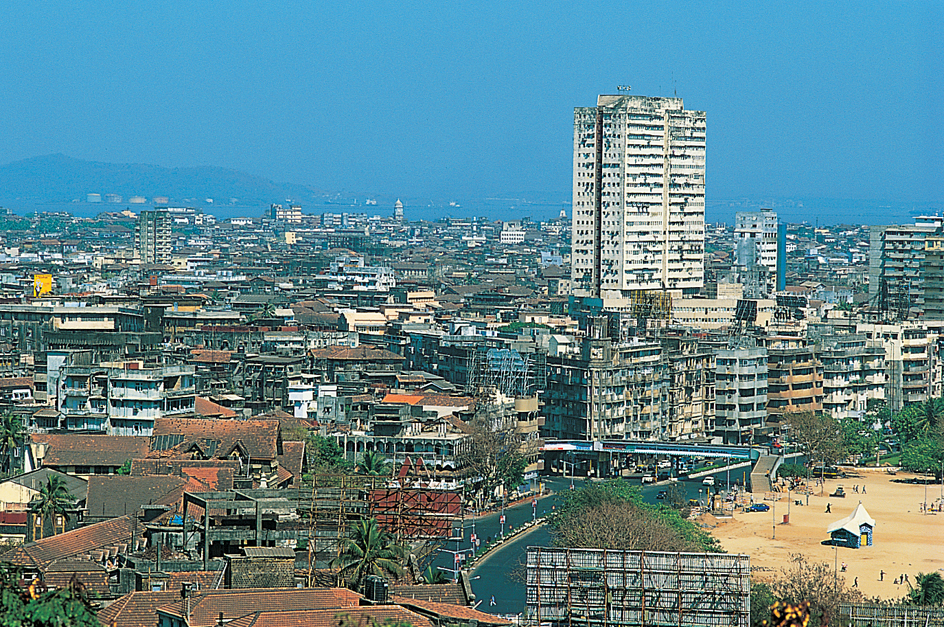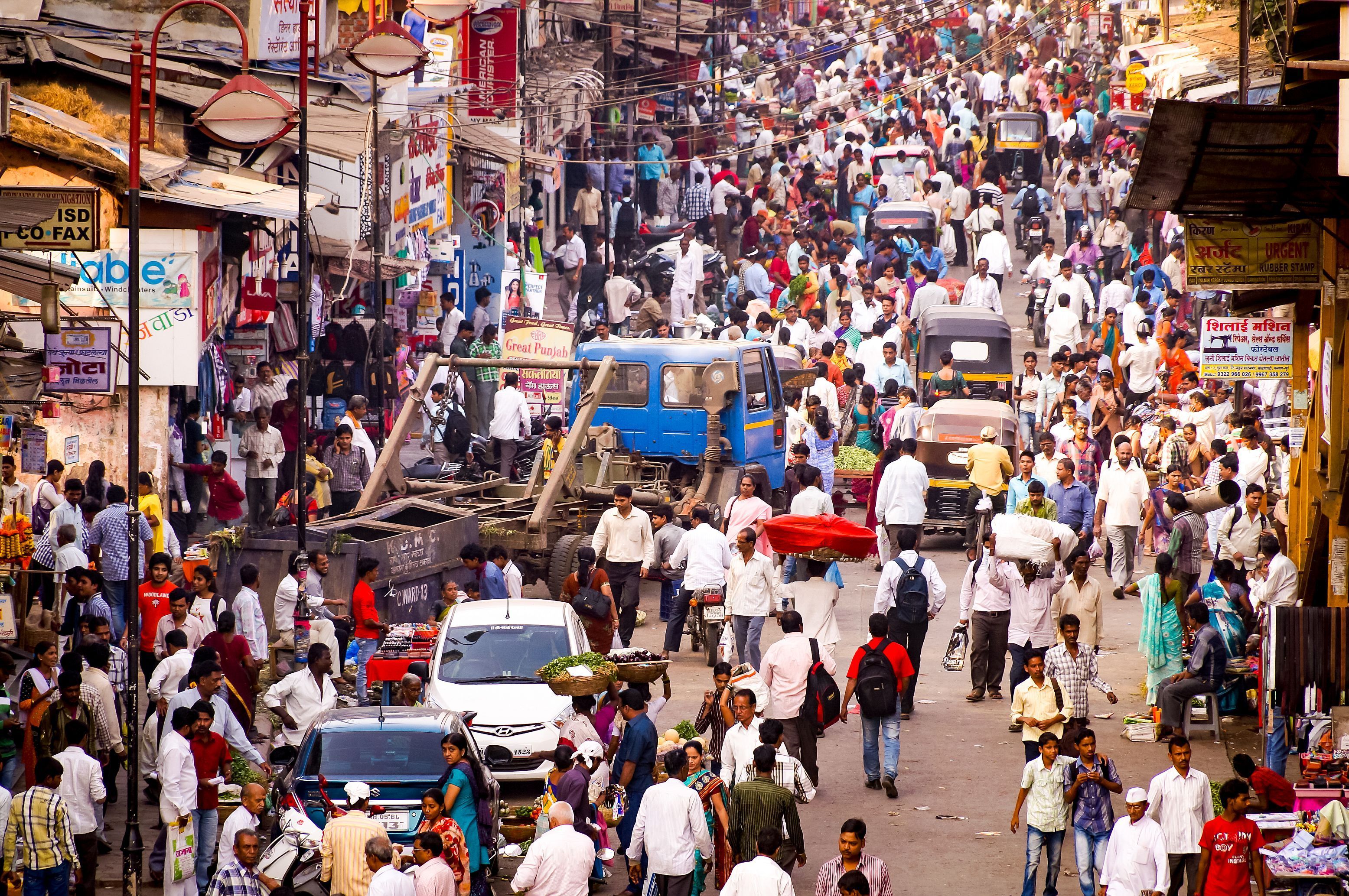Maharashtra (pop. 112,374,333) is a state on the northern part of India’s western coast. Its main center and capital is Mumbai (formerly known as Bombay). Maharashtra is mainly agricultural with a well-developed industrial sector. The state covers 118,809 square miles (307,713 square kilometers).

People and government
The people.
Maharashtra is home to many ethnic groups. The Bhil, the Gond, the Gowari, the Korku, and the Warli tribal groups living in the Satpura and Sahyadri ranges in the north are the aboriginal inhabitants of the region. The Kunbi Marathas are probably the descendants of immigrants from the north in the A.D. 100’s.
Parsis, also spelled Parsees, arrived in the region in the 1000’s, having migrated from Persia (now Iran). Mumbai has the largest concentration of Parsis in India (see Parsis).
Most of the people of Maharashtra speak Marathi, the regional language. Other languages include Bengali, English (particularly in Mumbai), Gujarati, Hindi, Kannada, Malayalam, Telugu, and Urdu. There is also a large number of dialects, including Konkani on the west coast, and Gondi in the northern regions.

Hinduism is the most popular religion, with Islam and Buddhism as the main minority religions. Most Parsis and Christians live in the cities. The Parsis are highly influential in the business community. There are also many Sikhs in the state (see Sikhism).
Maharashtra has many festivals throughout the year, and the majority of them are Hindu. They include Holi (which marks the beginning of spring), Ranga Panchami (a color festival), and Dassera (the day in autumn on which the Marathas usually began their military campaigns). Janmashtami, in July and August, celebrates the birth of Lord Krishna. Men and boys form human pyramids to break pots of curds that have been hung from high places. During Ganesha Chaturthi, held in Mumbai in August and September, massive figures of the elephant god Ganesha are immersed in the sea.
Muharram, the first month of the Islamic calendar, commemorates martyrs of Islam. The ninth month is celebrated as Ramzan (Ramadan), a time of fasting. Eid al-Fitr (`Īd al-Fitr), held on the day following the end of Ramadan, marks the end of the monthlong fast. Baqar `Īd (`Īd al-Ad-hā) is a festival of sacrifice.
Government.
Maharashtra has a governor as its head. The chief minister and council of ministers are elected from the state legislature and are responsible for shaping and carrying out policy. The chief minister is the leader of the largest party in the state parliament. The legislature has two houses: the Vidhan Parishad (legislative council), which has 78 members, and Vidhan Sabha (legislative assembly), which has 288 members.
At the district level, the chief administrative officer is called the collector. At the village level the gram panchayat (village council) operates.
Maharashtra has 48 elected members in the Lok Sabha (lower house), and 19 nominated representatives in Rajya Sabha (upper house) of the national parliament in New Delhi.
Economy
Agriculture.
Agriculture is of major importance in the economy. More than half of the population depends on farming for a living. More than a half of the total area of Maharashtra is under cultivation.
The main staple crops are rice, jowar (large millet), bajra (small millet), wheat, and pulses (beans, peas, lentils). The state is also a major producer of oil-seeds. These crops include peanuts and sunflowers.
Important cash crops are cotton, sugar cane, tobacco, turmeric, and a variety of vegetables. The state also produces fruit and has a substantial area devoted to bananas, grapes, sweet limes, mangoes, and oranges.
A major problem in Maharashtra is the scarcity of water. The state government has encouraged a more diversified agricultural system. The government gives assistance to farmers to improve the productivity of their farms. They have promoted higher yielding varieties of rice and wheat. Irrigation dams in areas of low rainfall have encouraged good sugar cane crops. Effort has also been made to improve the productive potential of dry lands through the integrated Watershed Development Programme.
Forest products
include bamboo and sandalwood. Tendu leaves are used for making cheap cigarettes, locally known as bidi.
Manufacturing.
The Mumbai-Pune industrial belt is one of the most important industrial regions in the country. Nagpur, Aurangabad, Sholapur, Thane and Kolhapur are also important. Maharashtra’s industrial products include chemicals, electrical and nonelectrical machinery, machine tools, petroleum, pharmaceuticals, and plastic goods. The oldest and largest industry in the state is textile production. Maharashtra also leads the country in the manufacture of sophisticated electronics equipment. Santacruz Electronics Export Processing Zone is a free trade zone for the export of electrical goods.
Mining.
In the eastern and western districts, mineral deposits are generally poor. There are small amounts of bauxite, copper, limestone, silica salt, and common salt. Bhandara, Nagpur, and Chandrapur districts in the east have rich deposits of bituminous black coal which is used by the railroads and power stations. There is offshore oil at the Mumbai High oil field.
Electric power.
Maharashtra produces both hydroelectricity and thermal electricity. The power station at Tarapur, India’s first nuclear power plant, is 6.2 miles (10 kilometers) north of Mumbai.
Motion-picture industry.
Mumbai is the center of India’s film industry, which is known as Bollywood. Mumbai produces hundreds of movies per year.
Tourism.
A large number of sites in Maharashtra attract visitors. Mumbai has many places of interest, and there are also other attractions in the state.
Transportation.
The transportation network radiates from Mumbai, which has connections by air, rail, and road with other parts of the country. Mumbai is one of the major international and internal airports in the country. The state also has many domestic airports.
Maharashtra has an extensive network or railroads and highways that connect the state with many of India’s cities.
Land and climate
Location.
Maharashtra is four sided with the western side on the Arabian Sea. The smallest side is the eastern side, which borders Chhattisgarh. Madhya Pradesh and Gujarat are to the north, and Goa, Karnataka, and Telangana are to the south.
Land features.
Maharashtra is a state with great physical diversity. In the west, bordering the Arabian Sea, is the Konkan Strip. This is widest near Mumbai and is nowhere wider than 62 miles (100 kilometers). In this strip are many small hills and streams.
Behind the Konkan Strip are the Western Ghats. These mountains form the western edge of the Deccan Plateau and run for 400 miles (640 kilometers) through the state from north to south. The highest peak reaches a height of 4,593 feet (1,400 meters). There are few gaps through which railroads and roads run. The western facing slopes are steep, but the eastern facing ones are gentle. Along the eastern slopes the great rivers of the plateau have carved wide valleys.
Between the Narmada Valley in the north and the Krishna Basin in the south are the Deccan Traps. This region is a series of lava outpourings which reach a depth of 9,843 feet (3,000 meters) near Mumbai. East of Nagpur the Deccan Traps give way to gently rolling hills 771 to 1,148 feet (250 to 350 meters) above sea level. The lava rock of the Deccan Traps breaks down into a black soil that is heavy but fertile.The crystalline rocks beneath produce sandy soils that are light in color and less productive.
Climate.
The monsoon dominates the state’s climate (see Monsoon). The southwest monsoon breaks on the coast in the first week of June and finishes in September. Four-fifths of the annual rainfall is received during this period.
The Western Ghats influence rainfall distribution. The coastal Konkan strip is wet. But the interior upland area behind them is much drier. Mumbai receives 106 inches (270 centimeters) a year on average, 95 percent of which is from June to September. Nagpur, on the other hand, receives 44 inches (113 centimeters) a year, 87 percent of which falls during the monsoon.
On the coastal strip of Maharashtra, daily maximum temperatures are fairly uniform throughout the year at an average of 90 °F (32 °C). The daily minimum temperature is 61 °F (16 °C) in January and 79 °F (26 °C) in June. In Aurangabad, the average daily maximum temperature in May is 104 °F (40 °C), and 84 °F (29 °C) in January. The minimum is 57 °F (14 °C) in January and 77 °F (25 °C) in May.
Plants and animals.
The natural vegetation depends largely upon the amount of rainfall an area receives. On the coast, there are bamboo, coconut, mango, myrabolan (for dyeing), and teak. On the plateau, in areas that receive heavy rain, bamboo, chestnut, and magnolia are common. Areas with less than 24 inches (60 centimeters) of rain a year have thorny vegetation.
Deer, hyenas, leopards, monkeys, and tigers live in the forests of the state, which cover less than 15 percent of the total area. Snakes are common and there are many birds, particularly ducks and peacocks.
Rivers and lakes.
A number of large and important rivers rise in the Western Ghats. The Girna flows northeast to join the Tapi (or Tapti), which drains into the Arabian Sea. The Godavari and the Krishna both flow across the Deccan plateau from west to east and enter the Bay of Bengal.
History
Early dynasties.
The origin of the name Maharashtra is unclear. It may come from the word rathi (chariot) whose drivers formed an army (maharathis). They probably migrated south and settled in the upland area in the 600’s. There they mingled with aboriginal tribes.
The territories making up present-day Maharashtra formed part of several Indian empires. The earliest empire to control the region was the Mauryan. Its most famous ruler was the emperor Ashoka, who lived during the 200’s B.C. (see Ashoka).
Between the 700’s and the 1300’s there were a number of Hindu kingdoms. These included the Satavahanas, the Kalacuris, the Rashtrakutas, the Chalukyas, and the Yadavas. The first Muslim dynasty was founded in 1307 and was followed by a string of others. The Muslims used Persian as the language of the court and this had a marked influence on the development of the Marathi language.
Rise of the Marathas.
In the 1400’s and 1500’s, the Maharashtra region went through a religious revival influenced by the “Sants” of bhakti, a devotional Hindu religion. By the middle of the 1500’s, Maharashtra consisted of several small kingdoms ruled by Maratha chieftains who spent much of their time fighting each other. In a reign that lasted from 1627 to 1680, the Marathan prince Shivaji welded these various Marathan kingdoms into a powerful state. The power of the new Marathan state was based on a strong, well-organized army. It threatened the Mughal empire in the north, weakened it through constant military campaigns, and contributed to its downfall.
The last Mughal emperor, Aurangzeb, spent nearly the whole of the second half of his reign fighting the Marathas in the Deccan Plateau. Aurangabad is named after him. See Aurangzeb.
The Mughal Empire could not withstand this sustained onslaught and gradually withdrew. During the 1700’s, nearly all western and central India and large portions of northern and eastern India came under the control of a Marathan confederacy. The imperial ambitions of the Marathas were shattered by the Afghans, who defeated them in the third Battle of Panipat in 1761, and later by the British, who fought them in three wars and eventually overcame them in 1817. The British administration annexed a large portion of Maratha territory to form a colonial administrative unit called the Bombay Presidency.
British rule.
Under the British, the Bombay Presidency administered western India. Bombay (now Mumbai) developed from seven small islands inhabited by Koli fishermen and their families. The East India Company had leased all of the islands from the British government, which in its turn had received them from Portugal in the late 1600’s (see Mumbai).
To begin with, Bombay’s fortunes rested on shipbuilding, which used the local Malabar teak. Later, the city took over from Surat in Gujarat as the company’s main center on the western coast of India. From this time onward it grew rapidly. The land between the islands was reclaimed, new streets were laid out, and impressive buildings were erected. Much of this progress was due to the energy and business acumen of the town’s Parsis. Soon Bombay became the commercial capital of India and the place where the majority of Europeans arrived in India.
Independence.
Indian opposition to British colonial rule found considerable support in Maharashtra. Several prominent nationalist and revolutionary leaders who were born in the region became actively involved in the struggle for independence. They included Dadabhoy Nauoroji, Gopal Krishna Gokhale, and Bal Gangadhar Tilak.
When India gained independence in 1947, the Bombay Presidency became Bombay state. In the following year, the government merged the former princely state of Baroda and some others with Bombay. With further reorganization in 1956, large areas of the former Hyderabad princely state and Madhya Pradesh became part of the large state. It had a Gujarati-speaking population in the north and a Marathi-speaking population in the south. As a result of demands from these two groups for separate states, the Indian government divided Bombay along linguistic lines into present-day Gujarat and Maharashtra, in 1960.
Recent developments.
In 1993, an earthquake devastated 50 villages in southern Maharashtra. The quake measured 6.5 on the Richter scale. Final estimates put the death toll at 11,000.

In 1996, Bombay’s name was officially changed to Mumbai.
